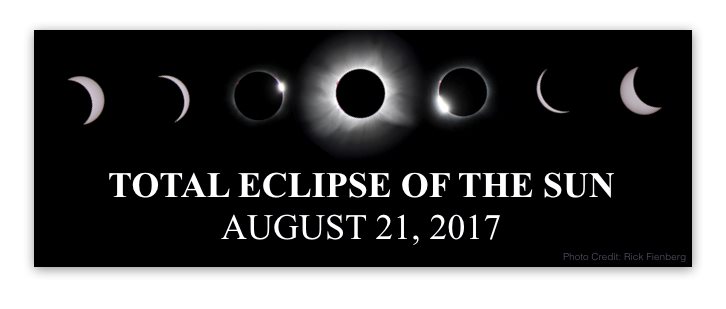Elon is offering resources and glasses to allow people to safely view the Aug. 21 solar eclipse, which will be close to a total eclipse at Elon with the moon blocking 93 percent of the sun at 2:43 p.m.
 Tony Crider, a professor of physics and astronomy expert at Elon, has been advising people for years to block off Aug. 21, 2017, on their calendars. Take the day off of work, or at least a couple of hours, because that day offers what might be the best chance in your lifetime to view a total solar eclipse, he’s told them.
Tony Crider, a professor of physics and astronomy expert at Elon, has been advising people for years to block off Aug. 21, 2017, on their calendars. Take the day off of work, or at least a couple of hours, because that day offers what might be the best chance in your lifetime to view a total solar eclipse, he’s told them.
“Trust me — you want to see this eclipse,” Crider said in an Elon video produced to offer information about the eclipse.
That day is now just weeks away, and the Elon community is preparing to take in what at 2:43 p.m. on Aug. 21 will be a 93 percent blockage of the sun by the moon. The “path of totality” — a swath of geography stretching southeast from Portland, Oregon, through Charleston, S.C. — passes south of Elon, with Crider and other astronomy buffs preparing to position themselves in the path to experience the phenomenon of the moon completely blocking the sun.
“This is going to be very noticeable, even at our campus,” Crider said. “We’re going to come really close to experiencing a total eclipse.”
To prepare for the long-awaited astronomic event, Elon has purchased 1,600 “eclipse shades” that contain special filters allowing the user to look directly at the sun. More than 100 of those have been donated to Early Middle College at Alamance Community College to allow high school students to experience the eclipse, said Brooke Barnett, associate provost for academic and inclusive excellence, who is helping with the planning.
Belk Library has already distributed a supply of 200, and Elon will hand out 1,200 pairs to faculty and staff members following the university’s Community Picnic on Aug. 21 at the start of Planning Week.
More information about the eclipse, along with where to pick up glasses and citizen science projects associated with the eclipse is available at www.elon.edu/eclipse. DO NOT look at the partial eclipse without glasses or use binoculars or telescopes to view the eclipse without specially designed filters for them.
The moon will achieve maximum blockage of the sun for this area at 2:43 p.m., with the university taking a break from 2:30 to 3 p.m. that day to allow everyone a chance to experience it. While the eclipse can be viewed anywhere there is an unobstructed view of the sun, Barnett said that the area in front of Inman Admissions Welcome Center is likely to be a popular viewing spot.
A total solar eclipse is one of nature’s most beautiful phenomena, Crider said. With the moon completely in front of the sun, the moon’s topography creates what’s called Baily’s beads, where beads of sunlight shine through in some places and not in others. Ringing the moon when it is completely in front of the sun will be a white solar corona, which is the plasma that surrounds the sun and other stars.
“You have this very beautiful, white corona that is faint and tenuous, but is very hot and glows hotter than the sun,” Crider said. “There’s nothing on earth that produces light like that. This is something that is not just scientifically interesting, but is also quite beautiful.”
The last time a total solar eclipse went through North Carolina was 1970, and the next time won’t be until 2078, Crider said. The path of the Aug. 21 eclipse will pass through a segment of far western North Carolina before heading into South Carolina, where it will pass through a large section in the middle of that state.


